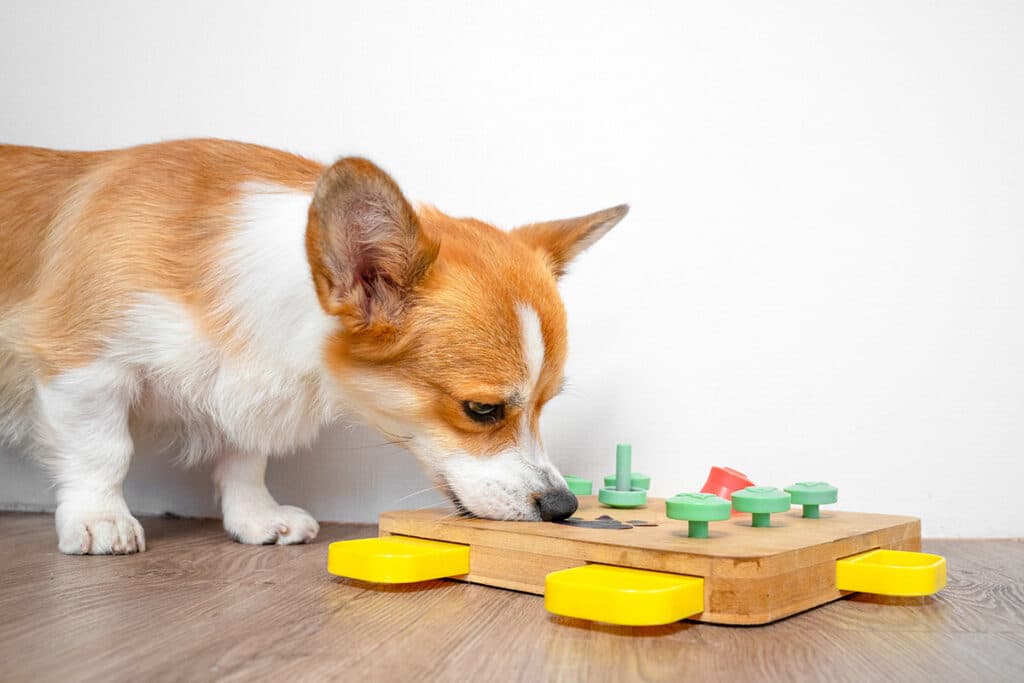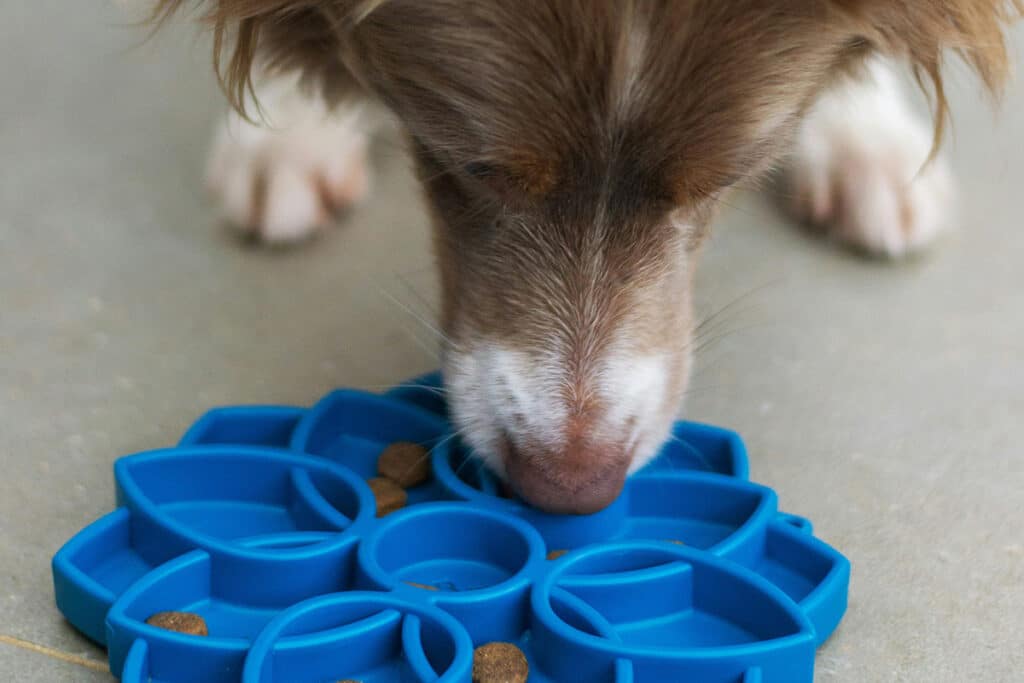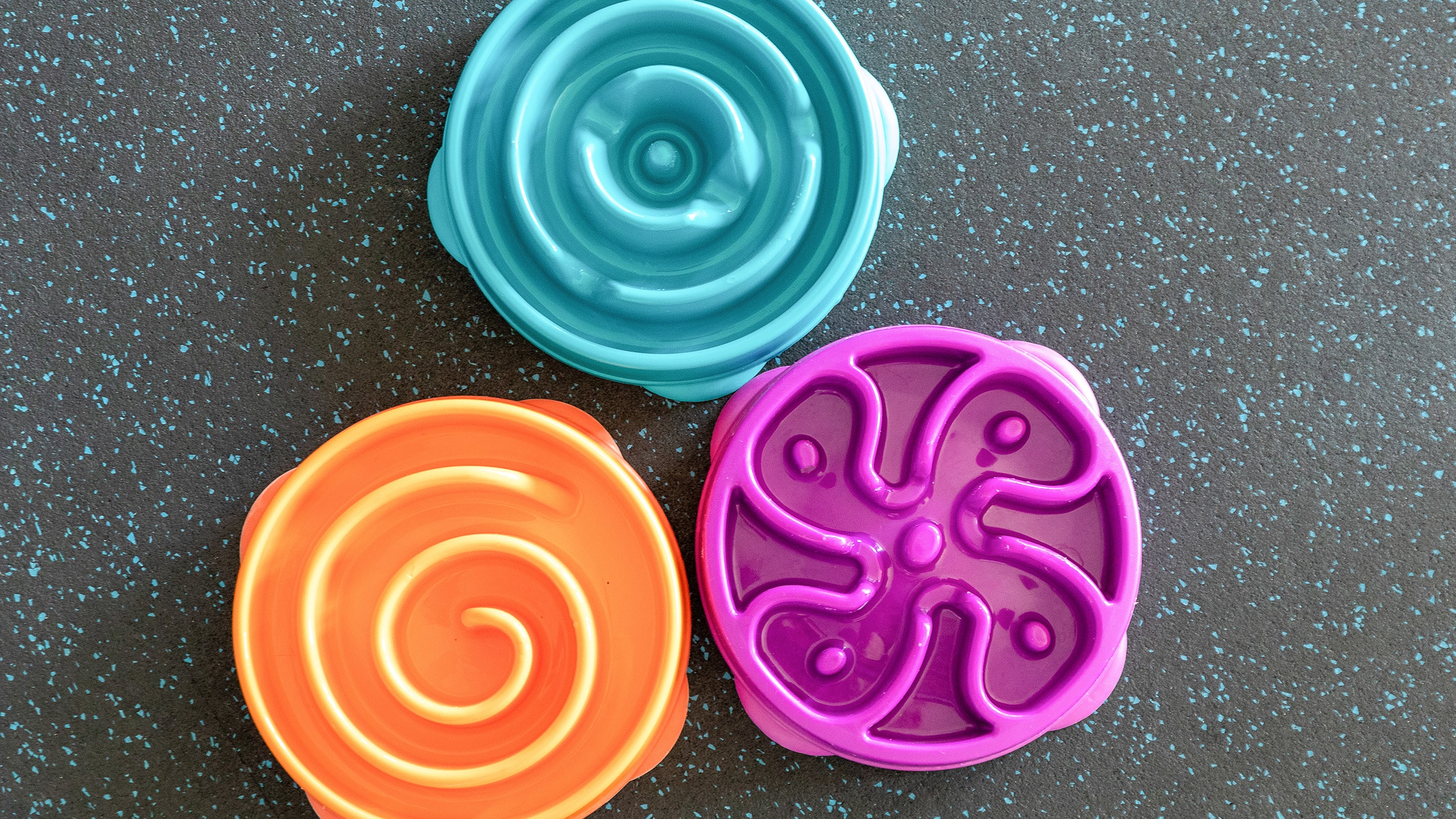Considering a slow feeder dog bowl to help control how quickly your pup downs their food? Maybe you’re not sure if they’re good for them, or if they even help. Well, the short answer is yes, slow feeders are good for your dog in a few different ways.
Slow feeders are mostly used to prevent your dog from eating their food too quickly, which can cause issues like choking, vomiting, or bloat. A slow feeder can help with these issues and also engage their minds at mealtime.
Do keep in mind, that slow feeders are not a one-size-fits-all affair. Some dogs might take some time to adapt, and some of these bowls won’t suit them at all.
In this article, we’ll take a look at specific benefits, and potential challenges, and answer the question “Are slow feeders good for dogs?” once and for all.
Key Takeaways
Slow feeder dog bowls improve a dog’s eating habits, which reduces the risk of choking, indigestion, and bloat by encouraging slower eating and smaller bites.
More than just improving digestion, slow feeders offer mental stimulation and can help manage issues such as food aggression by providing a challenging (and distracting) mealtime experience.
Selecting the right slow feeder for your dog involves weighing the size, age, and current eating habits of your pup; picking a compatible food comes into play here as well.
Table of Contents
Understanding Slow Feeders and Their Role in Canine Health
A slow feeder dog bowl is a uniquely designed dish that:
Encourages dogs to eat slower by limiting large bites.
Reduces the chance of choking or upset stomach.
Engages their minds as they figure out how to get every last morsel.
The clever construction of these slow feeders makes them particularly well-suited for speed eaters and gives you a better handle on following sound dietary practices.
Available in multiple shapes, dimensions, and configurations (not to mention colors!), there are endless options available to suit your dog in style. You can get super basic obstruction-type slow feeders, all the way up to intricate puzzle designs that force your pup to use their brains to unlock the goodies.
And don’t forget homemade options! We’ve seen people who take a regular bowl and glue in tennis balls or rocks – not advised – to act as obstructions. We’ll focus on store-bought options today, however.
The Mechanism Behind Slow Feeders
Slow feeder dog bowls have clever designs meant to turn feeding time into a stimulating activity for your four-legged friend.
These bowls incorporate elements like puzzles or mazes that the kibble fits into or use lick mats to create obstacles that your dog needs to work through to reach their food. This not only slows their pace of consumption but also provides valuable mental enrichment.
This innovative approach does more than simply slow their eating speed, it harkens back to instinctual canine behaviors such as hunting and deliberately picking apart a carcass each meal. So not only will they eat more slowly they will be mimicking the natural feeding patterns of their ancestors. This yields both nutritional and cognitive benefits.
The Link Between Slow Feeders and Preventing Bloat
Using a slow feeder is one of the best ways to help prevent a severe and potentially fatal condition in dogs known as bloat, or more formally Gastric Dilation-Volvulus (GDV). Bloat can happen when a dog ingests too much air while eating, leading to stomach expansion. This can end up twisting the stomach in a way that restricts blood circulation to various organs.
Deep-chested breeds like Great Danes, German Shepherds, and Boxers are particularly susceptible to bloat, though it is a risk for all breeds and sizes.
Adding a slow feeder to your dog’s routine can greatly reduce the likelihood of bloat by promoting more gradual eating habits and diminishing bite size. This will help limit the intake of air during mealtime, which is a key factor in avoiding stomach twists.
The Positive Impact of Slow Feeders on Dogs’ Eating Habits
By using slow feeder dog bowls consistently, you can improve your dog’s eating patterns in a few ways. These small changes can have a huge impact on their overall health.
These bowls will naturally adjust your dog’s eating pace to consume food at a more gradual speed, easing digestion. This both avoids regurgitation or vomiting after meals but also helps avoid choking on unchewed bits.
Better mastication (a super fancy word for chewing!) breaks food down adequately for better absorption of nutrients.
Maintaining a healthy weight is easier since their brain can register whether they’re full more accurately. They really can’t do this when they’re in full “go mode” to eat every bit of kibble as quickly as they can.
Mental Stimulation Through Mealtime Challenges
Feeding time can be more than just the daily ritual to get food in your pup’s body! Yes, they absolutely LOVE that ritual… but once they adapt, they can be even more fulfilled.

By adding a slow feeder, you’re leveling up your dog’s daily mental stimulation. Many of the bowls offer brain-engaging experiences and turn mealtime into an interactive event. The more challenging the puzzle, the more you’re maximizing the effects.
This sort of activity can sharpen a dog’s focus and contribute to their overall happiness beyond just the physical benefits seen above. This is achieved because pups are required to exert significant thought and physical work to access food from the crevices of the device.
Alleviating boredom can have a positive impact on other negative behaviors they may be exhibiting such as chewing furniture, getting into the trash, etc.
Even those dogs that eat at a more regulated pace can mentally benefit from slow feeders, especially the puzzle variety.
Managing Food Motivation and Aggression
Food aggression is a very common behavioral issue found in dogs. This aggression can originate from different factors such as:
past scarcity
health problems
competing with other dogs
hunger
Slow feeder dog bowls are designed to mitigate these aggressive habits by fully engaging a dog’s mind during the process of eating. This slower pace and full engagement distracts and trains a dog to focus more on the task at hand, rather than on insecurities or other causes of aggression.
Although these bowls don’t guarantee results like these, they certainly make positive contributions toward that goal.
Some slow feeders even come equipped with features that foster tranquility during mealtime. Elements like non-slip materials can lower stress levels in dogs that are fixated on their meals. You’d be surprised, but anxiety can develop simply by having a bowl constantly slipping away while they’re trying to eat.
Identifying If Your Dog Can Benefit From a Slow Feeder
To figure out if your dog could take advantage of the slow feeder benefits, look for behaviors like gulping down food quickly, regurgitating or vomiting shortly after eating, or displaying any anxiety around mealtime.
These signs may indicate your dog is eating too quickly and their stomach is upset or filled with too much air. They may very well benefit from the more measured pace of a slow feeder.
Also, if your dog was once in a rescue/impound situation, they may have faced stiff competition for their meals. These pups are great candidates to add a slow feeder to their routine since they may still have the perception of scarcity and competition.
Always remember that each dog is unique, so what works for one may not work for another. This is especially true if you have multiple dogs. Figure out what is right for each of them to reduce stress at mealtime. Feeding practices should be completely tailored to each of your pets.
Customizing the Slow Feeder Experience
Choosing the best slow feeder bowl for your dog requires taking into account aspects such as:
the size of your dog
its age
eating patterns
and the food type
Using these factors in determining the best option will ensure you meet each pup’s unique requirements. Deciding between the structure and complexity of a slow feeder should align with breed, size, and how they currently approach their meals.

You can find some that are relatively low-effort, but just take the edge of their speed, while others that require them to figure something out to get to the food. Pick a bowl that best suits their temperament, and frankly, how well they can get into the food. Curbing the speed of their ingestion is one thing, but preventing them from getting into their food is another. Stubborn pups may just refuse to deal with the obstacle!
Addressing Common Concerns With Slow Feeder Usage
Slow feeders indeed offer many advantages for dogs with overly quick consumption, but they do have a few drawbacks. As mentioned above, some dogs may simply get frustrated and give up before adapting to the new feeding regimen.
This frustration may surface with them gnawing on or destroying the feeder. Once a bowl is damaged, it is much harder to keep free of bacteria due to the crevices and cracks. Trying a silicone feeder may help alleviate this if your dog is prone to chew. Metal and other materials can also be used to construct slow feeder bowls.
Lick mats can serve as an outlet for frustration as well. You may have to experiment, or even have a bowl damaged in the hunt for the perfect fit. But don’t give up… these are some of the best tools to counteract the speed eating.
Ensuring Safety and Suitability
You need to spend some extra time watching your dog eat the first few meals with their new slow feeder bowls. Overly ambitious pups that haven’t figured out a new way of getting to their food can harm their teeth, especially if the bowls are made of particularly tough materials.
And, while we wouldn’t advise leaving a slow feeder in a dog crate with a dog post-meal if you can avoid it, it may still happen. Watch for any signs of idle chewing the first few times by spying on your pup a little bit to see what their level of interest is in the slow feeder. If they do chew and break off tough pieces of material, those can be swallowed and harmful to their digestive tract.
Equally important is to ensure the design of the slow feeder is appropriate for your dog and doesn’t cause any physical or mental discomfort. Watch for signs of disinterest in eating, which could cause too low of food intake. A slow feeder may not be a fit for that particular pup.
Integrating Slow Feeders Into Your Dog’s Routine
Now that you’ve decided to try out a slow feeder, let’s talk about how to incorporate them into your dog’s feeding schedule.
Start by introducing it slowly, perhaps once per day or every other meal. Let them investigate it and take extra time to navigate its complexity. They may be nervous, challenged, or have a variety of other emotions, but it’s important to give them enough time to work through it.

You can even combine both a slow feeder dog bowl with a regular bowl. A little bit of food in each, and they will start to understand the transition if they want to finish off their meal. Be creative!
Combining Slow Feeders With Regular Bowls
Using a combination of bowls can help them spend a little extra time switching between them, encouraging more chewing. This chewing will not only slow them down but also break the food down better for better nutrient uptake.
Try combining wet food in one and dry in another. If they REALLY love their wet food, that may be the right starting point for the slow feeder since it’ll entice them to figure it out even more so. Just make sure to thoroughly clean every nook and cranny to avoid potential bacteria buildup.
Enhancing Mealtime With Slow Feeders and Quality Nutrition
Understanding how slow feeders work, we can now make your dog’s mealtime more successful and use that to improve their overall well-being. Combining these tools and techniques with premium dog food, or better yet, homemade dog food, we can tailor mealtime to meet their specific needs.
Although not the primary objective of this post, we can’t go without mentioning the benefits of proper nutrition and how it impacts your pet’s health and happiness. We’ve written about various things such as superfoods for your pets and balancing nutrition and exercise on this blog. It’s worth a look if you’re taking your role as a provider seriously reading this article.
Selecting the Right Food for Your Slow Feeder
Deciding on the dog food to pair with a slow feeder should be based on what your dog’s dietary needs require. Their taste preferences should play a role as well. While dry kibble is the most commonly used food, certain bowls can handle wet food without making the cleaning process too difficult.
When portioning the food, you need to be aware of how the dish’s structure affects how the meal is delivered. Watch out for any elevated structures within the bowl to ensure you’re taking full advantage of the pacing the dish will provide. If it’s just piled on top, it defeats the purpose of the bowl and you should invest in a larger size.
Summary
So, are slow feeders good for dogs? Absolutely. The innovations found in these designs have revolutionized a simple but important part of your pup’s daily life. By slowing them down and avoiding ingesting too much air, we can significantly reduce the likelihood of a catastrophic even that puts their health in serious jeopardy.
However, like any tool, properly sizing and implementing the dish is equally, if not more important than buying one in the first place. Remember to integrate it gradually, and it can be a game-changer in your dog’s health and happiness.
Frequently Asked Questions
Do dogs get frustrated with slow feeders?
Indeed, dogs that are accustomed to eating quickly may experience irritation when confronted with slow feeder bowls, potentially causing mealtime tension.
Observing your dog’s response while they’re engaging with a slow feeder is crucial.
What is a slow feeder dog bowl?
A dog bowl known as a slow feeder incorporates puzzles, mazes, or obstacles within its design to engage dogs during mealtime and deliberately decelerate their eating speed to avoid overconsumption.
How does a slow feeder prevent bloat in dogs?
By promoting smaller bites and a slower pace of eating, a slow feeder can minimize the amount of air dogs swallow while they eat. This reduced air intake during feeding helps to lower the chances of stomach twisting which can be a life-threatening condition.
Utilizing such feeders is instrumental in helping dogs moderate their eating habits, ensuring they consume their meals more slowly, which contributes significantly to averting the risk of bloat.
Can a slow feeder help with food aggression?
Indeed, by utilizing a slow feeder to curb rapid eating tendencies, one can address food aggression and simultaneously offer a cognitive task that may steer away from aggressive conduct related to feeding.
What type of food should I use with a slow feeder?
Slow feeder bowls are typically used with dry kibble. Certain slow feeders are capable of accommodating wet or raw dog food as well.
